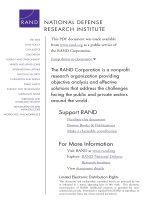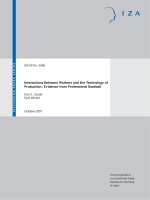The cost of production mankiw
Bạn đang xem bản rút gọn của tài liệu. Xem và tải ngay bản đầy đủ của tài liệu tại đây (534.13 KB, 45 trang )
© 2007 Thomson South-Western
The Costs of Production
• The Market Forces of Supply and Demand
– Supply and demand are the two words that
economists use most often.
– Supply and demand are the forces that make
market economies work.
– Modern microeconomics is about supply,
demand, and market equilibrium.
© 2007 Thomson South-Western
WHAT ARE COSTS?
• According to the Law of Supply:
– Firms are willing to produce and sell a greater
quantity of a good when the price of the good is
high.
– This results in a supply curve that slopes upward.
© 2007 Thomson South-Western
WHAT ARE COSTS?
• The Firm’s Objective
– The economic goal of
the firm is to
maximize profits.
© 2007 Thomson South-Western
Total Revenue, Total Cost, and Profit
• Total Revenue
• The amount a firm receives for the sale of its
output.
• Total Cost
• The market value of the inputs a firm uses in
production.
© 2007 Thomson South-Western
Total Revenue, Total Cost, and Profit
• Profit is the firm’s total revenue minus its total
cost.
• Profit = Total revenue - Total cost
© 2007 Thomson South-Western
Costs as Opportunity Costs
• A firm’s cost of production includes all the
opportunity costs of making its output of goods
and services.
• Explicit and Implicit Costs
• A firm’s cost of production include explicit costs
and implicit costs.
• Explicit costs are input costs that require a direct outlay
of money by the firm.
• Implicit costs are input costs that do not require an outlay
of money by the firm.
© 2007 Thomson South-Western
Economic Profit versus Accounting Profit
• Economists measure a firm’s economic profit as
total revenue minus total cost, including both
explicit and implicit costs.
• Accountants measure the accounting profit as
the firm’s total revenue minus only the firm’s
explicit costs.
© 2007 Thomson South-Western
Economic Profit versus Accounting Profit
• When total revenue exceeds both explicit and
implicit costs, the firm earns economic profit.
• Economic profit is smaller than accounting
profit.
© 2007 Thomson South-Western
Figure 1 Economists versus Accountants
How an Economist
Views a Firm
How an Accountant
Views a Firm
Economic
profit
Accounting
profit
Revenue
Implicit
costs
Explicit
costs
Revenue
Total
opportunity
costs
Explicit
costs
© 2007 Thomson South-Western
PRODUCTION AND COSTS
• The Production Function
– The production function shows the relationship
between quantity of inputs used to make a good
and the quantity of output of that good.
© 2007 Thomson South-Western
The Production Function
• Marginal Product
• The marginal product of any input in the production
process is the increase in output that arises from an
additional unit of that input.
© 2007 Thomson South-Western
Table 1 A Production Function and Total Cost: Hungry
Helen’s Cookie Factory
© 2007 Thomson South-Western
The Production Function
• Diminishing marginal product is the property
whereby the marginal product of an input
declines as the quantity of the input increases.
• Example: As more and more workers are hired at a
firm, each additional worker contributes less and
less to production because the firm has a limited
amount of equipment.
© 2007 Thomson South-Western
Figure 2 Hungry Helen’s Production Function
Quantity of output
Number of Workers Hired
© 2007 Thomson South-Western
The Production Function
• Diminishing Marginal Product
• The slope of the production function measures the
marginal product of an input, such as a worker.
• When the marginal product declines, the production
function becomes flatter.
© 2007 Thomson South-Western
From the Production Function to the
Total-Cost Curve
• The relationship between the quantity a firm
can produce and its costs determines pricing
decisions.
• The total-cost curve shows this relationship
graphically.
© 2007 Thomson South-Western
Table 1 A Production Function and Total Cost: Hungry
Helen’s Cookie Factory
© 2007 Thomson South-Western
Figure 2 Hungry Helen’s Total-Cost Curve
Total
Cost
Quantity
of Output
(cookies per hour)
© 2007 Thomson South-Western
THE VARIOUS MEASURES OF
COST
• Costs of production may be divided into fixed
costs and variable costs.
– Fixed costs are those costs that do not vary with
the quantity of output produced.
– Variable costs are those costs that do vary with
the quantity of output produced.
© 2007 Thomson South-Western
Fixed and Variable Costs
• Total Costs
•
•
•
•
Total Fixed Costs (TFC)
Total Variable Costs (TVC)
Total Costs (TC)
TC = TFC + TVC
© 2007 Thomson South-Western
Table 2 The Various Measures of Cost: Thirsty Thelma’s
Lemonade Stand
© 2007 Thomson South-Western
Fixed and Variable Costs
• Average Costs
• Average costs can be determined by dividing the
firm’s costs by the quantity of output it produces.
• The average cost is the cost of each typical unit of
product.
© 2007 Thomson South-Western
Fixed and Variable Costs
• Average Costs
•
•
•
•
Average Fixed Costs (AFC)
Average Variable Costs (AVC)
Average Total Costs (ATC)
ATC = AFC + AVC
© 2007 Thomson South-Western
Average and Marginal Costs
AFC =
Fixed cost FC
=
Quantity
Q
Variable cost VC
AVC =
=
Quantity
Q
Total cost TC
ATC =
=
Quantity
Q
© 2007 Thomson South-Western









